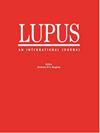狼疮的早期诊断:一种可能性。印度风湿病学协会(IRA)系统性红斑狼疮特别兴趣小组(SIG)的一项多中心研究。
IF 1.9
4区 医学
Q3 RHEUMATOLOGY
引用次数: 0
摘要
简介系统性红斑狼疮(SLE)需要早期诊断和及时治疗。延误诊断可能导致病情反复发作、永久性损伤甚至死亡。世界各地诊断系统性红斑狼疮所需的时间差异很大。我们开展了这项研究,以确定印度诊断系统性红斑狼疮所需的时间,并找出相关因素。方法在一项横断面多中心问卷调查中,纳入了根据系统性红斑狼疮国际合作诊所标准(SLICC)2012 年标准在过去 1 年内确诊的系统性红斑狼疮患者。调查记录了患者的人口统计学特征、根据库普斯瓦米社会经济地位分类(2022 版)(SES)自我报告的社会经济地位,以及包括转诊模式在内的多个医疗保健相关参数。结果 我们纳入了来自 10 个风湿病中心的 488 名系统性红斑狼疮患者。诊断时间的中位数为 6 个月四分位数(IQR 3,14.7),约三分之一的患者[150(30.7%)]在 3 个月内确诊。78名(16.0%)患者的诊断时间非常短(<1个月)。确诊时系统性红斑狼疮疾病活动指数(SLEDAI)的平均值为10.28+7.24。在单变量分析中,年龄较大、社会经济地位较低、居住地非南方州以及家庭人口较多与诊断较晚有显著相关性。在多变量分析中,较高的社会经济地位(AOR 0.95,95% CI:0.92-0.98)、初次发病时多个器官系统受累(AOR1.75 95%CI:1.08-2.84)和居住地在印度南部各邦(AOR1.92 95%CI:1.24-2.97)与晚期诊断相关的几率较小。与最近的医疗中心/专业人员的距离并不影响诊断时间。大多数患者首次就诊时是在医学专业毕业的医生(42.5%)或研究生医生(48.2%)处,而转诊至风湿免疫科医生的大多是研究生医生(65%)。结论系统性红斑狼疮的平均诊断时间为 6 个月,其中三分之一的患者在 3 个月内确诊,78 例(16.0%)患者在症状出现 1 个月内确诊。社会经济地位较低的人群和患有单一器官疾病的人群的诊断时间较晚。距离医疗机构的远近并不影响诊断时间。本文章由计算机程序翻译,如有差异,请以英文原文为准。
Early diagnosis of lupus: A possibilty. A multicentric study from SLE Special Interest Group (SIG) of Indian Rheumatology Association (IRA).
INTRODUCTION
Systemic Lupus Erythematosus (SLE) warrants an early diagnosis and prompt management. Delay in diagnosis can result in repeated flares, permanent damage, and even death. There is a large variability in the time taken to diagnose SLE across the world. We undertook this study to determine the time taken for diagnosis of SLE in India and to identify the factors associated.
METHODS
Patients with SLE diagnosed within the previous 1 year as per Systemic Lupus Erythematosus International Collaborating Clinics criteria (SLICC) 2012 criteria were included in a cross-sectional multicentre questionnaire-based survey. Demographic profile, self-reported socioeconomic status as per Kuppuswamy classification of socioeconomic status (version 2022) (SES), and several healthcare related parameters including referral pattern were recorded. Median time taken for diagnosis was used to demarcate early or late diagnosis and associated factors were explored.
RESULTS
We included 488 patients with SLE from 10 rheumatology centres. The median time to diagnosis was 6 months Interquartile Range (IQR 3,14.7) and within 3 months in about one third [150(30.7%)]. Very early diagnosis (<1 month) was established in 78(16.0%) patients. The mean SLE Disease Activity Index (SLEDAI) at diagnosis was 10.28+7.24. In univariate analysis, an older age, lower SES, non-southern state of residence and larger family size were significantly associated with late diagnosis. In the multivariate analysis, higher SES (AOR 0.95, 95% CI: 0.92-0.98), multiple organ system involvement at initial presentation (AOR1.75 95%CI: 1.08-2.84) and place of residence in south Indian states (AOR1.92 95%CI: 1.24-2.97) had lesser odds of being associated with late diagnosis. Distance from the closest medical centre/professional did not influence the time to diagnosis. Majority of patients had first consulted a medical graduate (42.5%) or postgraduate doctor (48.2%), and referral to rheumatologist was largely done by postgraduate (65%) doctors. More than half of our patients (61%) self-finance their treatment.
CONCLUSION
Median time to diagnosis of SLE was 6 months, 1/3rd being diagnosed within 3 months and 78(16.0%) with 1 month of symptom onset. Delay in diagnosis was noted in those belonging to lower socioeconomic strata and those with single organ disease. Distance to the health care facility did not influence time to diagnosis.
求助全文
通过发布文献求助,成功后即可免费获取论文全文。
去求助
来源期刊

Lupus
医学-风湿病学
CiteScore
4.20
自引率
11.50%
发文量
225
审稿时长
1 months
期刊介绍:
The only fully peer reviewed international journal devoted exclusively to lupus (and related disease) research. Lupus includes the most promising new clinical and laboratory-based studies from leading specialists in all lupus-related disciplines. Invaluable reading, with extended coverage, lupus-related disciplines include: Rheumatology, Dermatology, Immunology, Obstetrics, Psychiatry and Cardiovascular Research…
 求助内容:
求助内容: 应助结果提醒方式:
应助结果提醒方式:


